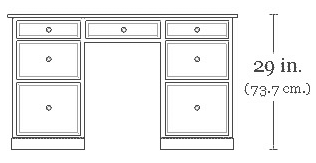
A pedestal desk or a tanker desk is usually a large, flat, free-standing desk made of a simple rectangular working surface resting on two pedestals or small cabinets of stacked drawers of one or two sizes, with plinths around the bases. Often, there is also a central large drawer above the legs and knees of the user. Sometimes, especially in the 19th century and modern examples, a "modesty panel" is placed in front, between the pedestals, to hide the legs and knees of the user from anyone else sitting or standing in front. This variation is sometimes called a "panel desk". The smaller and older pedestal desks with such a panel are sometimes called kneehole desks, they were intended for small spaces like boudoirs and were usually placed against a wall. The kneehole desks are also known as bureau tables.

A writing table has a series of drawers directly under the surface of the table, to contain writing implements, so that it may serve as a desk. Antique versions have the usual divisions for the inkwell, the blotter and the sand or powder tray in one of the drawers, and a surface covered with leather or some other material less hostile to the quill or the fountain pen than simple hard wood.

Duncan Phyfe was one of nineteenth-century America's leading cabinetmakers.

A commode is any of many pieces of furniture. The Oxford English Dictionary has multiple meanings of "commode". The first relevant definition reads: "A piece of furniture with drawers and shelves; in the bedroom, a sort of elaborate chest of drawers ; in the drawing room, a large kind of chiffonier." The drawing room is itself a term for a formal reception room, and a chiffonier is, in this sense, a small sideboard dating from the early 19th century.

A table is an item of furniture with a raised flat top and is supported most commonly by 1 to 4 legs. It is used as a surface for working at, eating from or on which to place things. Some common types of tables are the dining room tables, which are used for seated persons to eat meals; the coffee table, which is a low table used in living rooms to display items or serve refreshments; and the bedside table, which is commonly used to place an alarm clock and a lamp. There are also a range of specialized types of tables, such as drafting tables, used for doing architectural drawings, and sewing tables.

George Nelson was an American industrial designer. While lead designer for the Herman Miller furniture company, Nelson and his design studio, George Nelson Associates, designed 20th-century modernist furniture. He is considered a founder of American modernist design.
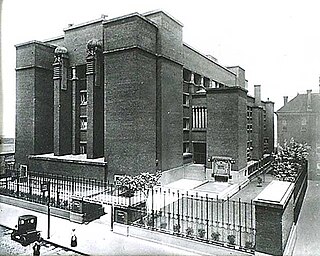
The Larkin Building was an office building in Buffalo, New York, noted for innovations that included central air conditioning, built-in desk furniture, and suspended toilet partitions and bowls. Located at 680 Seneca Street, it was demolished in 1950.
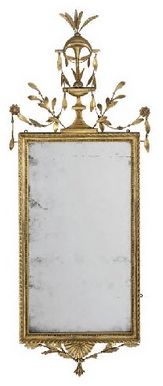
A pier glass or trumeau mirror is a mirror which is placed on a pier, i.e. a wall between two windows supporting an upper structure.

The Green Room is one of three state parlors on the first floor of the White House, the home of the president of the United States. It is used for small receptions and teas. During a state dinner, guests are served cocktails in the three state parlors before the president, first lady, and a visiting head of state descend the Grand Staircase for dinner. The room is traditionally decorated in shades of green. The room is approximately 28 by 22.5 feet. It has six doors, which open into the Cross Hall, East Room, South Portico, and Blue Room.

A poker table or card table is a table specifically designed for playing card games.
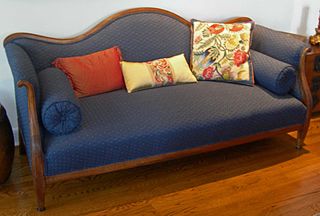
A lyre arm is an element of design in furniture, architecture and the decorative arts, wherein a shape is employed to emulate the geometry of a lyre; the original design of this element is from the Classical Greek period, simply reflecting the stylistic design of the musical instrument. One of the earliest uses extant of the lyre design in the Christian era is a 6th-century AD gravestone with lyre design in double volute form. In a furniture context, the design is often associated with a scrolling effect of the arms of a chair or sofa. The lyre arm design arises in many periods of furniture, including Neoclassical schools and in particular the American Federal Period and the Victorian era. Well known designers who employed this stylistic element include the noted New York City furniture designer Duncan Phyfe.

Millford Plantation is a historic farmstead and plantation house located on SC 261 west of Pinewood, South Carolina. It was sometimes called Manning's Folly, because of its remote location in the High Hills of Santee section of the state and its elaborate details. Designated as a National Historic Landmark, it is regarded as one of the finest examples of Greek Revival residential architecture in the United States. The house has been restored and preserved along with many of its original Duncan Phyfe furnishings.
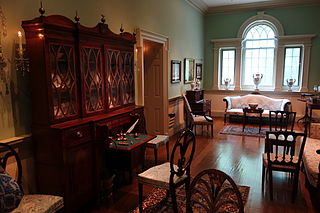
Federal furniture refers to American furniture produced in the federal style period, which lasted from approximately 1789 to 1823 and is itself named after the Federalist Era in American politics. Notable furniture makers who worked in the federal style included John and Thomas Seymour, Duncan Phyfe and Charles-Honoré Lannuier. It was influenced by the Georgian and Adam styles, and was superseded by the American Empire style.
Italian Baroque interior design refers to high-style furnishing and interior decorating carried out in Italy during the Baroque period, which lasted from the early 17th to the mid-18th century. In provincial areas, Baroque forms such as the clothes-press or armadio continued to be used into the 19th century.

A Tip-top table is a folding table with the tabletop hinged so it can be placed into a vertical position when not used to save space. It is also called tilt-top table, tip table, snap table some variations are known as tea table, loo table. These multi-purpose tables were historically used for playing games, drinking tea or spirits, reading and writing, and sewing. The tables were popular among both elite and middle-class households in Britain and the USA in the 18th and 19th centuries. They became collector's items early in the 20th century.

A cabinet is a case or cupboard with shelves or drawers for storing or displaying items. Some cabinets are stand alone while others are built in to a wall or are attached to it like a medicine cabinet. Cabinets are typically made of wood, coated steel, or synthetic materials. Commercial grade cabinets usually have a melamine-particleboard substrate and are covered in a high-pressure decorative laminate, commonly referred to as Wilsonart or Formica.
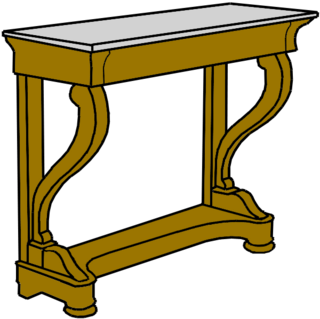
A console table is a table whose top surface is supported by corbels or brackets rather than by the usual four legs. It is thus similar to a supported shelf and is not designed to serve as a stand-alone surface. It is frequently used as pier table, to abut a pier wall.

The furniture of Louis XIV was massive and lavishly covered with sculpture and ornament of gilded bronze in the earlier part of the personal rule of King Louis XIV of France (1660–1690). After about 1690, thanks in large part to the furniture designer André Charles Boulle, a more original and delicate style appeared, sometimes known as Boulle work. It was based on the use of marquetry, the inlay of pieces of ebony and other rare woods, a technique first used in Florence in the 15th century, which was refined and developed by Boulle and others working for the King. Furniture was inlaid with thin plaques of ebony, copper, mother of pearl, and exotic woods of different colors in elaborate designs.

Louis XVI furniture is characterized by elegance and neoclassicism, a return to ancient Greek and Roman models. Much of it was designed and made for Queen Marie Antoinette for the new apartments she created in the Palace of Versailles, Palace of Fontainebleau, the Tuileries Palace, and other royal residences. The finest craftsmen of the time, including Jean-Henri Riesener, Georges Jacob, Martin Carlin, and Jean-François Leleu, were engaged to design and make her furniture.

Nest of tables is a set of few tables with progressively smaller heights and frames, so that they can be stacked when not in use. A smaller table slides inside the frame of a larger one until it engages the edge of the back frame.




















